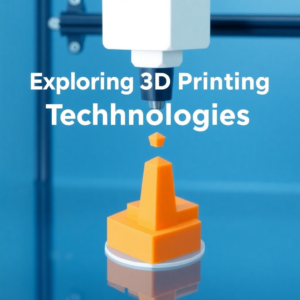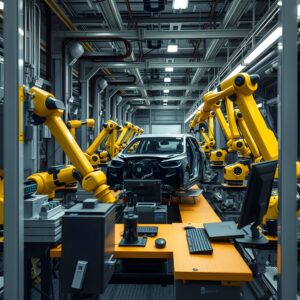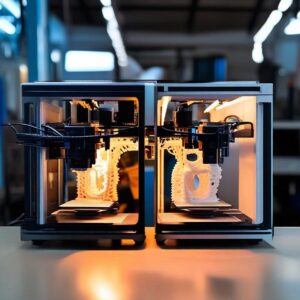A New Era in Lightweight, Eco-Friendly Travel

In a world where sustainability and minimalism are becoming increasingly vital, iScale3D is pushing the boundaries of innovation with the launch of their 3D-printed tiny camper. This camper is a significant step toward the future of travel, offering eco-conscious adventurers a chance to experience mobility, comfort, and sustainability like never before.
Tiny homes have become a growing trend, reflecting a shift toward more compact, mobile, and efficient living. The global tiny home market has seen exponential growth as more individuals seek alternative ways of living, many of which incorporate sustainable living practices. iScale3D’s decision to tap into this growing market with a 3D-printed camper is revolutionary, as it combines cutting-edge technology with the minimalistic nature of tiny living. The result is a lightweight, customizable, and eco-friendly solution to the modern traveler’s needs.
This article explores the intricate details behind iScale3D’s tiny camper, including its design, the 3D printing process used to create it, its key features, and the significant impact it could have on the tiny home and travel industries. We will also delve into the environmental and economic benefits, the market potential, and how this development is setting the stage for the future of 3D-printed living spaces.
About iScale3D
Founded in 2018, iScale3D is a pioneer in the 3D printing industry, specializing in the use of innovative printing techniques to create a range of products across various industries, from aerospace to automotive to construction. Their mission is simple: to transform traditional manufacturing by harnessing the potential of 3D printing to make production more sustainable, efficient, and customizable.
The company has made strides in advancing the use of 3D printing in construction and design, offering solutions that not only improve efficiency but also reduce waste and energy consumption. Their work in the building and design sectors has garnered attention from both eco-conscious consumers and industry professionals alike, and the launch of their 3D-printed tiny camper is the latest example of their commitment to sustainability and innovation.
iScale3D’s approach is grounded in the use of high-quality, eco-friendly materials, which are key in crafting products that are both durable and environmentally friendly. By working with experts in the field of 3D printing and design, the company has managed to create a product that not only meets the practical needs of its consumers but also aligns with the growing demand for sustainable and eco-conscious solutions.
The Concept of a 3D-Printed Tiny Camper
The concept of the 3D-printed tiny camper is both innovative and timely. Tiny homes, which are typically under 400 square feet, have become an increasingly popular choice for those seeking to downsize, reduce their carbon footprint, or pursue a minimalist lifestyle. The popularity of tiny homes, including tiny campers and RVs, has spiked due to the freedom they offer — the ability to travel, live off-grid, and escape the traditional constraints of homeownership.
While many tiny homes are made using traditional building materials, iScale3D has taken a bold step by using 3D printing to construct their camper. The concept is relatively simple: use 3D printing technology to construct an entirely customized, eco-friendly tiny camper that reduces waste, speeds up production, and lowers overall costs. This approach stands in stark contrast to traditional camper construction, which often involves the use of heavy materials, lengthy build times, and a significant environmental impact.
3D printing, also known as additive manufacturing, is a process where layers of material are built up from a digital design to form a final product. This process allows for an unprecedented level of customization, where every aspect of the camper, from the structure to the interior layout, can be tailored to meet the specific needs and desires of the owner. The ability to 3D print structures allows for lightweight materials, reduced waste, and faster production times — a stark contrast to the traditional methods used in the construction of campers, which can be costly and time-consuming.
In addition to the environmental benefits, 3D printing allows for a level of creativity and customization that would be nearly impossible with conventional construction methods. The iScale3D tiny camper can be personalized in ways that traditional campers simply cannot match, from the layout of the living spaces to the choice of materials and finishes. As such, the camper becomes a truly unique and personal space, making it an ideal solution for those who want to travel without sacrificing comfort or sustainability.
Design and Build Process
The design and build process behind the iScale3D tiny camper is nothing short of groundbreaking. The process begins with the creation of a digital model, which serves as the blueprint for the camper. This model is then input into the 3D printer, where layers of material are gradually built up to form the structure. iScale3D uses a variety of eco-friendly materials for the camper, including recycled plastics and sustainable composites, which not only make the camper lightweight but also ensure its environmental footprint is minimized.
One of the key benefits of using 3D printing in the construction of the camper is the ability to reduce material waste. Traditional manufacturing methods often result in significant amounts of scrap material, but with 3D printing, only the material required for the build is used, reducing waste and making the process much more efficient.
The materials used in the build process are carefully chosen for their durability, strength, and sustainability. The outer shell of the camper is printed using a composite material that is both lightweight and strong enough to withstand the rigors of travel. This material is also designed to be weather-resistant, ensuring that the camper can handle a variety of environmental conditions.
The interior of the camper is equally important, and iScale3D offers a range of customizable options for consumers. From the layout to the furnishings, the interior can be tailored to the individual’s preferences. This includes everything from the placement of windows and doors to the choice of flooring, countertops, and cabinetry. The result is a fully customized camper that meets the specific needs of the traveler.
Key Features of the iScale3D Tiny Camper
One of the most impressive aspects of the iScale3D tiny camper is the array of features designed to make travel more convenient, comfortable, and eco-friendly. Here are some of the key features:
Customizable Design
As mentioned, the camper can be fully customized, with different layouts, sizes, and finishes. Whether a traveler wants a minimalist space with a simple bed and kitchenette or a fully equipped mobile home, the design can be adjusted accordingly.
Sustainable Materials
The materials used for the construction of the camper are all chosen for their sustainability. The use of recycled plastics and other eco-friendly materials reduces the environmental impact of production and ensures that the camper is as green as possible.
Energy-Efficient Systems
The camper is equipped with energy-efficient systems, such as solar panels, LED lighting, and energy-saving appliances. These systems help to reduce the camper’s reliance on external power sources, making it an ideal choice for off-grid living.
Water and Waste Management
The iScale3D camper also features an innovative water and waste management system. This includes water-saving appliances, such as low-flow faucets and showers, as well as a waste management system that allows for easy disposal and recycling.
Compact and Lightweight
Thanks to the 3D printing process, the camper is incredibly lightweight, making it easy to tow and maneuver. This also means that the camper has a smaller carbon footprint when it comes to transportation.
Environmental and Economic Benefits
The environmental benefits of the iScale3D tiny camper are immediately apparent. By utilizing 3D printing and eco-friendly materials, the company is significantly reducing waste and lowering the carbon footprint of camper production. Traditional camper manufacturing methods often involve the use of large quantities of raw materials, many of which are not recyclable, and the processes themselves can be energy-intensive. In contrast, 3D printing uses only the material necessary to create the product, resulting in less waste and a more efficient use of resources.
The use of sustainable materials also plays a key role in reducing the environmental impact of the camper. Materials such as recycled plastics and sustainable composites are not only durable but also less harmful to the environment than conventional building materials. This makes the iScale3D camper a truly eco-friendly choice for those looking to reduce their environmental footprint.
Economically, 3D printing allows iScale3D to reduce production costs and pass those savings on to the consumer. Traditional camper manufacturing involves complex assembly lines, expensive raw materials, and long lead times. In contrast, the 3D printing process is much more streamlined, allowing for faster production times and lower costs. This makes the iScale3D tiny camper more affordable, especially for those looking for an entry-level option in the tiny home or camper market.
The Market for 3D-Printed Campers
The market for tiny homes and campers has been on the rise for years, with many consumers seeking alternative living solutions that are more affordable, sustainable, and mobile. iScale3D’s 3D-printed tiny camper is perfectly positioned to meet the demands of this growing market. Eco-conscious travelers, digital nomads, and those looking for affordable alternatives to traditional homes are increasingly turning to tiny homes and campers as a way to live more simply and sustainably.



